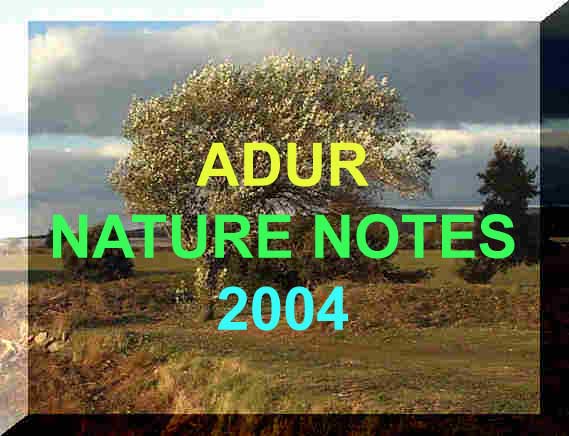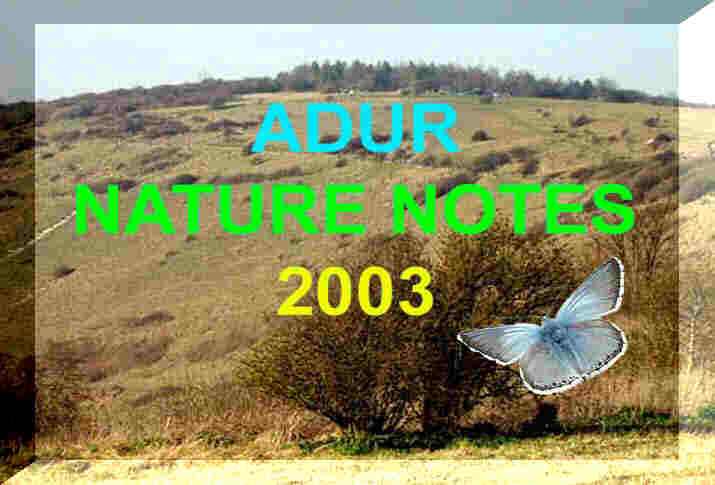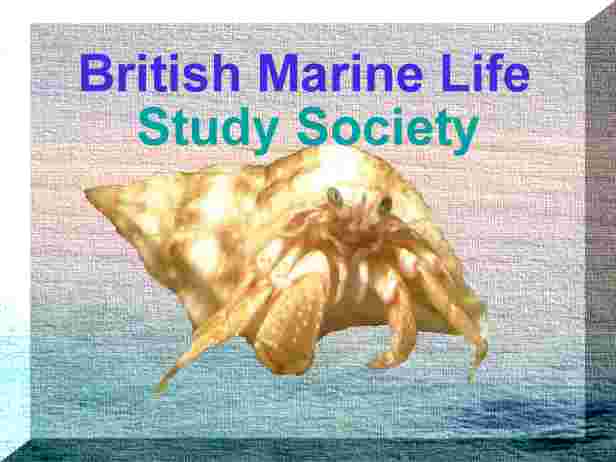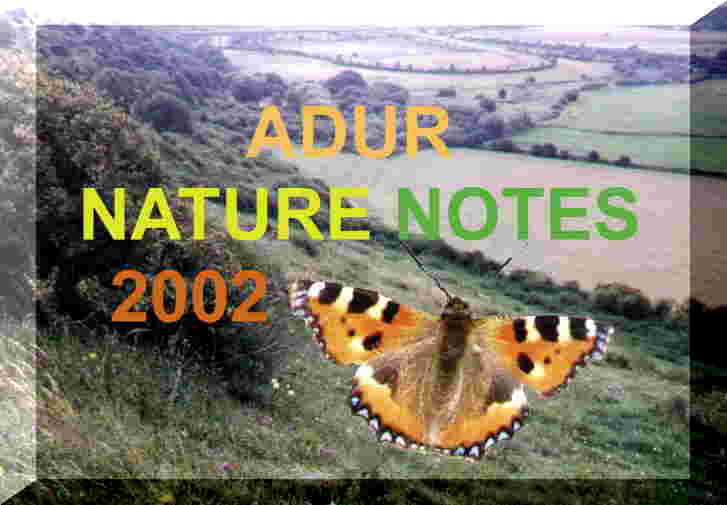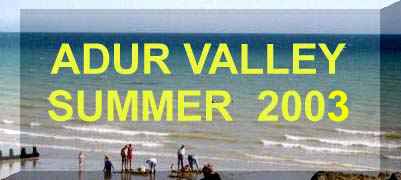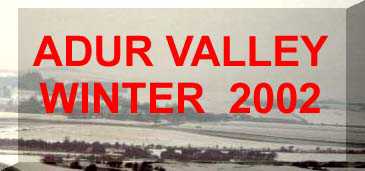| WILDLIFE
REPORTS
All
reports by Andy Horton unless the credits are given
to other observers or reporters.
CLICK
ON THIS TEXT FOR THE JANUARY 2004 REPORTS
31 December
2003
The
last bird of 2003 is an omnipresent Pied
Wagtail in the road, wagging its tail
as dusk set in.
Urban
Wildlife Webring
28
December 2003
After
over 40 mm of rain the previous day and over night, the water level of
Widewater
Lagoon on the gauge by the bridge is 66 mm, the highest level recorded
in 2003.
27
December 2003
In
a heavy but brief downpour from 2:00 pm,
over 2 mm of rain descended in 10 minutes, turning day into night. By sunset
(4:00 pm) a total of 18.54 mm rain was recorded
on Shoreham Beach, almost all of it occurring in three hours in the afternoon.
By midnight,  the
rainfall total had reached 33.27 mm (1.31"), which was the highest of the
year, and greater than the total rain that fallen earlier in December
2003 (total = 62.23 mm). Almost all the rain
had fallen after midday.
For most of the time, the rain was classified as "Light Rain". the
rainfall total had reached 33.27 mm (1.31"), which was the highest of the
year, and greater than the total rain that fallen earlier in December
2003 (total = 62.23 mm). Almost all the rain
had fallen after midday.
For most of the time, the rain was classified as "Light Rain".
(1
inch = 25.4 mm)
Previous
Highest Rainfall Day 2003
22
December 2003
The
Winter
Solstice occurred at at 6:51 GMT (Universal
Time). And it felt like winter as well, with
a northerly breeze, and air temperature scarcely creeping above freezing:
0.8 ºC to 3.8 ºC, and both the dew point and wind chill were
below zero for the whole day. Precipitation was nil with a clear sky.
Six
Long-tailed
Tits visited the large Hawthorn
Tree at the end of my south Lancing garden
(TQ
186 044) for a meal of hawberries.
Small flocks of these tiny birds tend to visit gardens in hard weather.
14
December 2003
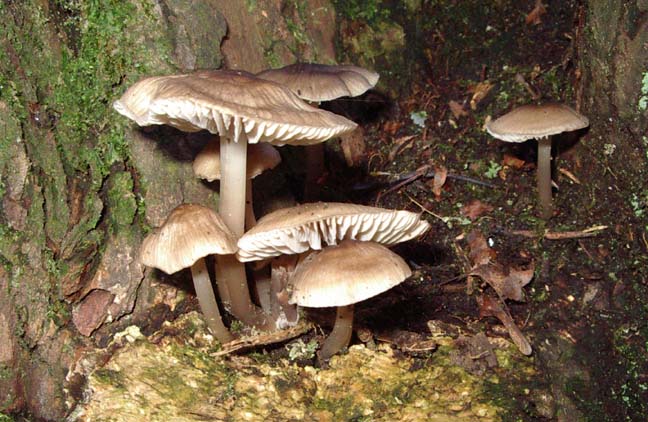 Friends
of Lancing Ring Christmas Walk 10:00
am Friends
of Lancing Ring Christmas Walk 10:00
am
After
the deluge of yesterday we were lucky to squelch through the mud of the
meadows and paths of Lancing Ring under a clear blue cloudless sky in a
pleasant 9° C.
About 25 ramblers made a circuitous journey past the now full dewpond,
down the westerly side where we were met by a chilly (9°
C) fresh breeze
from the south-west. On the decaying beech logs the variety of fungi was
past its best. In the forage-harvested short cropped meadows there
were several clumps of the orange-brown Tubaria
furfuracea mushroom.
Full
Report
5 December
2003
A
Little
Auk settled on the sea off Widewater
Lagoon at 1:00 pm.
Sea
off Sussex
4 December
2003
Absent
last month, but now the bracket fungi has appeared on the logs as
the cyclepath widens by the road layby
south of Beeding Cement Works. Shining white with lawyer's wig top to its
cap, the Shaggy Ink Cap, Coprinus
comatus, was distinct amongst the undergrowth
of brambles next to one of the logs.
An
old tree just
off the Waterworks Road was covered in clumps of the distinctive Jew's
Ear Fungus, Hirneola auricola-judae.
The
trees were mostly bare except for the
brown
Ash
keys and the galls in the Silver
Birch.
Fungi
of Shoreham (with more images)
2 December
2003
In
the sombre winter landscape, the bright yellow belly of a Yellowhammer
was
clear and distinctive in the fields to the west of the Steyning Road north
of Old Shoreham and the A27 Flyover. The bird appeared to be feeding on
the grazing land by the stream and then flew into a Hawthorn or similar
tree where it could be seen because all the leaves had fallen. The vegetation
had been cut back on both sides by the stream.
On
the eastern side of the A283 Steyning road a pair
of Grey Herons
took off on my approach. The usual
Moorhens
were not seen or heard in the afternoon.
A small
reddish toadstool poked its cap out from amongst the grass and chopped
reeds laid prone to rot on the bank. The cap was under 20 mm across, but
then another larger specimen had a flat cap at 35 mm in diameter. This
species is Tubaria
furfuracea. It is very common on damp
wood fragments or even in rough grassland, especially late in the season.
(Laccaria
laccata has thicker, more distant and more irregular gills and
has been uncommon this season.)
At
the foot of a Hawthorn Tree there was a clump of Coprinus mushrooms.
These look like Glistening Inkcap,
Coprinus
micaceus. Against the gate on the eastern side in the sheep grazed
field a couple of logs lay prone. They were covered in small clumps of
the bracket fungi Stereum
hirsutum and unidentified mushrooms..
Fungi
of Shoreham (with more images)
Narrow
Field next to the stream between the Steyning Road and the Waterworks

28 November
2003
According
to the DETR page the short life span
of about two years for urban Foxes
is because they are run over and killed on the roads. Around Shoreham,
this seems to happen on the country roads just outside of town.
The
Fox
in the photograph was killed on the busy A27 road by the Sussex Pad where
fatalities have occurred before.
26
November 2003
A
big furry tail was the first indication of the healthy Red
Fox seen before in Corbyn Crescent area
of Shoreham where I live.
Full
Report and Links
23
November 2003
A
considerable amount of heavy rain fell continuously throughout the day,
stopping as darkness fell. By midnight the total was 27.69 mm (1.09").
This was the greatest amount of rainfall in a single day this year and
the heaviest since 10 August 2002.
On 22 November 2003
the rainfall total was 14.93 mm.
Rain
Rate Graph
20
November 2003
A
Peregrine
Falcon flew over Southwick Green scattering
the local Collared Doves.
And at Happy Valley (behind Slonk Hill), Shoreham, two Stonechats
were recorded. New Erringham Farm produced a flock of about 25 Corn
Buntings, plus a further five on the road
to Truleigh Hill.
19
November 2003
Brooklands
Boating Lake was visited for the first time since the reports of
it being drained of water
for repairs. This has left patches of black smelly mud, but there is still
extensive shallow water where the large population of Coots,
Mallards,
Moorhens
and Black-headed Gulls can rest, with
at least one Mute Swan. Over
the grass there were a few Crows,
a
handful of Herring Gulls and
a visiting male Kestrel.
(Some of the Mute Swans
died and others were removed by WADARS
after the mysterious deaths earlier this year.)

|

|
Birds
around a rock with
the
mystery organism growing on it
|
A
dumped motorcycle covered
in
the strange worm
|
A strange
worm was noticed for the first time growing on the stems of reeds and on
solid objects in Brooklands Boating Lake.
It
has not been seen in Brooklands since the lake was created. It was first
spotted this summer from the seaward southern end and spread all over the
lake but not to the full freshwater reaches called the Teville Stream.
This is the feeder stream from the north.
Report
with information from Mrs Hawkins

Mystery
from Brooklands 2003
 At
the time of writing I have not identified the animal which could be a worm
or a bryozoan? The reasonable speculation was that it has been able to
become established this year because of increased salinity
in the low brackish water lagoon, because of the profound lack of rainfall
this year. There are sluice gates separating the lake from the sea, and
the juvenile stages must have arrived with a seawater intake. At
the time of writing I have not identified the animal which could be a worm
or a bryozoan? The reasonable speculation was that it has been able to
become established this year because of increased salinity
in the low brackish water lagoon, because of the profound lack of rainfall
this year. There are sluice gates separating the lake from the sea, and
the juvenile stages must have arrived with a seawater intake.
Brooklands
Lake (new web page)
The
mystery organisms are the empty tubes of the serpullid
worm, Ficopomatus
enigmaticus.
R.S.K.
Barnes in "The Brackish-water fauna of Northwestern
Europe" writes about this worm:
"A
southern species often termed Mercierella, that extends northwards
to the southern North Sea. It will construct its c. 1 mm diameter, up to
30 mm long tubes on most substrata, natural and artificial, including the
stems of Common Reed, Phragmites, and is particularly characteristic
of harbours, docks, artificial lagoons and power-station outfalls with
salinities of from 35 down to 10 ppt (and exceptionally, in fresh water);
it has also been recorded from several natural lagoons. The tubes, which
possess circular, shelf-life platforms near their mouths, are often aggregated
into large colonies."
Our
Dutch name translates into: "trumpet-calcareous-tube-worm" since the tube
often looks as a series of trumpets.
JNCC
Information Page on Ficopomatus enigmaticus
16
November 2003
On
a bright, cloudless sunny morning, a Red
Admiral Butterfly fluttered over my south
Lancing garden (TQ 186 044) garden
in westerly direction.
14
November 2003
In
the Strong Breeze (Force 5)
all the silver leaves have now been blown off the
White Poplar on Adur Recreation Ground
photographed
below. There were no leaves on the broad-leaved trees near the exposed
river bank.
13
November 2003
Foraging
on the shingle just above the reach of the gently lapping sea, or just
perched on the tideline, a small flock of twenty Turnstones
between the rock groynes just east of the Church of the Good Shepherd (on
Shoreham
Beach), were the largest number I had seen in Shoreham together.
In
half an hours slow cycle ride from New Salts Farm to Cuckoo's Corner (via
Shoreham Airport), I must have spotted about
twenty Moorhens,
in the fields with cows and in drainage ditches and small overgrown streams.
This is more than usual, although this water bird hides amongst the reeds
and they may just have been venturing out and it does not necessarily reflect
increasing numbers.

|

|
|
My
suspicion is that the bush in the foreground was deliberately planted on
the Lancing College (west) side of the road opposite Cuckoo's Corner
|
This
bush has been identified as the Snowberry,
Symphoricarpos
albus, a native American plant introduced to Britain in 1817. ID
by Ray
Hamblett
|
As
dusk drew in, the estimated count of one flock of Lapwings
flying south over the River Adur near Cuckoo's Corner (on the Coombes Road)
was 300.
Adur
Levels
12
November 2003
Brooklands
Boating Lake (east
Worthing on the Lancing border) has been partially drained of water so
that repairs to the wooden supports of the embankment can be carried out.
A Little
Egret visited the lake for the first time,
perhaps appreciating the lowered water levels.
The is
also an authentic report of a pair of Canadian
Geese paying a brief visit to the muddy
lake.
Previous
Bird Report
8 November
2003
Will
the Red Admiral Butterfly that
flew strongly northwards at roof eaves level across Gordon Road, Shoreham,
be the last of the year?
7 November
2003

Discovered
in the twitten between Corbyn Crescent
and Adelaide Square, Shoreham, on the edge of the Middle Road allotments,
I have identified the two mushrooms seen as the species known as the
Shaggy
Parasol,
Macrolepiota
rhacodes. This a grassland species about the size of a commercial
mushroom.
Adur
Town & Gardens
Adur
Fungi: Fruiting Bodies (Monthly Guide)
Naked
of their leaves, the Ash Trees
on the Downs Link cyclepath midway between
Old Shoreham and the Cement Works still had masses of rust-coloured keys,
and these provided some shelter for visiting small flock of Long-tailed
Tits.
Adur
Levels
6
November 2003
Just
as I was resigned to the end of summer, a shirt sleeves sunny 16.6
ºC brought a Clouded
Yellow Butterfly fluttering over the waste
land next to the river just north of Adur Riverside Industrial Park (north
of Ropetackle), Shoreham, in the late morning. Just after midday a Red
Admiral Butterfly fluttered over the bushes
by the railway track in Dolphin Road, Shoreham, and later in the afternoon
another Red Admiral
fluttered over the path by horse's field on the south-west approaches of
Mill
Hill, (south of the A27 main road). The
constant breeze remained from the south-east for the second day running.
Adur
Butterflies Flight Times
UK
November Butterflies
2 November
2003
In
the morning, a Moderate Gale (Force 7 gusting to Force 8, maximum at 47
mph), with rain, stripped the Sycamores of their leaves. The maximum gust
was only attained
on
one occasion previously this year on 2
May 2003 at 50 mph, and then the average 20
mph (Fresh Breeze, Force 5) was not so persistent. Gales continued constantly
for over two hours in the morning, the first constant gales of 2003.
Beaufort
Scale

31 October
2003
A
Common
Darter Dragonfly,
Sympetrum
striolatum, was
seen flying over garden in Lime Tree lined Monks Avenue, Lancing.
Common
Darter Images
Trees
of Urban Lancing (Picture Portfolio)
After
nearly 25 mm of rain in the last three days and the high tides, Widewater
was in flood and the spit at the east end near the island was completely
under water. The height reading was 65 mm. This level was higher than at
any time this year.
Widewater
Salinity and Water Levels
A small
flock of Long-tailed Tits
were a pleasant attraction at Cuckoo's Corner (on the Coombes Road), favouring
a Sycamore Tree
near the new swing gate between the towpath and the car park, but also
venturing into the taller trees where a Greater
Spotted Woodpecker was clearly seen on
the side of a tree trunk.
30
October 2003
A
Hummingbird
Hawk-moth, Macroglossum
stellatarum, was seen nectaring on
the Verbena bonariensis to
my south Lancing garden (TQ 186 044). Will
this be the last sighting of the year?
29
October 2003

White
Poplar, Populus
alba
Adur
Recreation Ground in the Afternoon
Over
one hundred Cormorants
flew over the Adur levels, with a few in the River
Adur, between Old Shoreham and Botolphs, in just over an hour. I had not
seen so many before. Normally, I would expect to see under thirty.
Cormorant
Roost (Link)
There
were a handful of Moorhens
in
the stubble field to the east of Applesham Farm and a young Roe
Deer.
The
trees are again beginning to form a dark canopy on the approach road to
Coombes from Shoreham.
Images
of Autumn Trees near Shoreham
Native
British Tree List
British
Trees (Old Site Index)
27
October 2003
It
looks like it could very well have been a Sparrowhawk
in a garden in North Farm Road, Lancing. (NB: it could have been a Kestrel?)
26
October 2003
A
Fox
entered the town centre of New Shoreham, being seen
in the middle of the day on the lawn of a back garden in John Street. The
street frontage is tightly packed terraced cottages on a narrow side road
but there are a few larger houses and gardens.
Report
by Martin
Red
Admiral and Speckled
Wood Butterflies were seen in a Cokeham
(west Lancing) garden near the reed beds. The distinctive screech of Water
Rail was also heard.
Cokeham
Reed Beds
 25
October 2003 25
October 2003
The
dew
point fell freezing point in the early morning at -0.8° C and the
first frost-like covering of the winter occurred. The air temperature only
fell to 3.9 ºC although the wind chill fell to below zero. The early
morning sky was a bright blue.
Leaf
Litter (CD-ROM only)
24
October 2003
A
pair of Grey Herons
in the horse's field at the top of The Street, Old Shoreham, was a slightly
incongruous and unusual sight. A single Heron
on the river or the lowland pastures is frequent,
but they are rarely seen together, and I have not seen them in this field
before, which is right on the edge of the town with
Mill
Hill, (south of the A27 bypass), although less than a half of mile
by the most direct route from their normal haunts.
 22
October 2003 22
October 2003
Summer
seems to be over with hailstones, a chilly south-easterly breeze (Force
4) and a perpetually grey overcast sky with rain showers.
On Brooklands
Boating Lake (east Worthing on the Lancing border), there were about 80
Coots,
over a dozen Mallard,
two Mute Swans,
one Pochard
and one Moorhen.
On the beach sand a score or more of Great
Black-backed Gulls rested and there were
at least three
Redshanks
feeding in the Widewater shallows at the eastern
end of the lagoon.
Brooklands:
Mallards & Coots Image
21
October 2003
The
black and white wing was the first indication of an Oystercatcher,
Haematopus
ostralegus, that descended to land
on the loose rock shore of Kingston Beach on
a low neap tide, on a sunny day with a bright blue
sky. A careful watch for a few minutes through my binoculars and the Oystercatcher
was attempting the repeated stabbing with its medium-length black beak,
which is a behavioural characteristic of this bird. It was meant as one
of several techniques to stab at mussels to get
at the rich flesh inside.It was not successful and the tide would not go
out any further to reveal the mussel beds (on a 1.9 metre low neap tide)
and there would not be more than an occasional mussel exposed, and it may
have been stabbing at the hinges of exposed cockles?
The
red legs of the Oystercatcher were
matched by a well camouflaged Redshank
between the launching ramp and the first groyne.
Oystercatchers
on Lundy (Behaviour)
Over
the shallow pool near the Lifeboat Station the red breast of a Kingfisher
stood
out from the pipeline it was perched on. Ironically, a couple of Crows
had managed to prise out a small clump of mussels.
My
Last Butterflies of October 2003 (Link)
20
October 2003
On
and around Brooklands Boating Lake (east Worthing
on the Lancing border), there were two Kingfishers, two Grey
Wagtails and four Goldcrest.
The
chill northerly breeze felt like winter for the first time since February,
and the temperature was only 8.5 ºC at 5:00 pm.
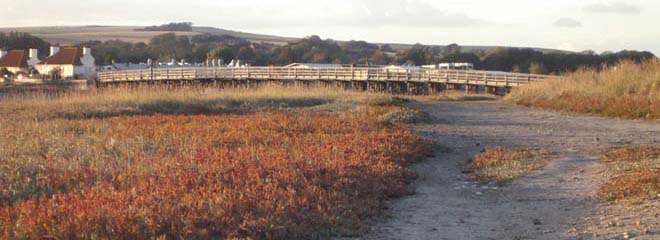
Although
not quite so dramatic as the Glasswort,
Salicornia,
on
Widewater, the
Sea Blite on the estuarine
margins had turned a distinctive dark red.
Adur
Mudflats
19
October 2003
A
Great
Grey Shrike was seen on the Hawthorns
on the west side of Lancing Ring above the recycling
plant early in the morning from 7.50 - 8.05
am. After scaring the the local birds it then
flew west out of sight in the direction of Findon Valley.
Full
Report
Grey
Grey Shrike Information Page
These
rather distinctive toadstools (fungi) appeared underneath the Buddleia
in the garden of 40 The Drive (near Buckingham Park), Shoreham-by-Sea,
(TQ
219 063). They are almost certainly
the Glistening Inkcap,
Coprinus
micaceus. These mushrooms are probably
edible when fresh in spring and fried in butter.
"Your
photograph shows the effects of the prolonged dry spell. The cap is cracking
and gills have probably dried out (and died) rather than deliquesced."
(Malcolm Storey BioImages)
Fungi:
Technical Bits
Town
& Gardens
Fungi
of Lancing Clump
Fungi
Database
Fungi
(Adur Biodiversity) Links Page
Lancing
Ring Fungi in October (Lancing Nature Web Pages)
Fungi
of the British Isles (Yahoo Group)
Basidiomycete
Checklist
Adur
Fungi: Fruiting Bodies (Monthly Guide)
18
October 2003
There
was a Kestrel motionless
in the branches of a Hawthorn Tree
on the northern edge of grazing land immediately north of the Chalk Pit,
east of Lancing Clump. Another Kestrel
soared over for an hour and then suddenly dived into the Hawthorn
Tree in Ray
Hamblett's south Lancing garden (TQ
186 044) causing 30+ House
Sparrows, a Robin,
a Dunnock
and a Blue Tit
to fly rapidly into cover.
It
was in the same garden that a pristine Small
Tortoiseshell Butterfly landed on Verbena
bonariensis. This butterfly
was an orangey colour rather than the reddish colour of many of the summer
Small
Tortoiseshell Butterflies.
A
dozen
Common
Darter
Dragonflies
congregated at the top of McIntyres field, near Lancing Ring.
A
single Mute Swan
was drifting with the current offshore of Widewater
Lagoon. It is uncommon to see Mute Swanson
the sea itself.
17
October 2003
In
the clear morning light I had another
distant view of the "bird
of prey" I saw a couple of days ago. The light was better and I really
now think it is most likely a female Kestrel
(which
I thought it was in the first place). However, it still was a dark chocolate
brown in colour, still seemed about to hover, but never did so (it just
stalled briefly in flight), and spent part of the time chasing small birds
amongst the bushes (which Kestrels do
in autumn). The disposition of the tail in flight was Kestrel-like
and the light underwing as well.
15
October 2003
A
Water
Rail,
Rallus
aquaticus, was heard screeching in the Cokeham
Reed Beds, west Lancing.
Bird
List for Cokeham
Its
caw (call) was a cross between that of a Magpie
and a Crow, but
it looked more like an overlarge Thrush
or Blackbird:
a couple of Ring Ouzels,
Turdus
torquatus, looked a very dirty black with a white/grey breast as
they chose Hawthorn bushes
ahead of other shelter on the lower slopes of
Mill
HiIl. According to the Shoreham
& District Ornithological Society 1988 "Birds
of Shoreham" the peak month for migrating Ring
Ouzels is October. The Sussex
Ornithological Society status for the Ring
Ouzel is as a scarce passage migrant.
 A
hawk was perched for at least a few minutes
on another Hawthorn
bush that stood out amongst the clump of scrub that forms and extensive
border of Mill Hill with the field on the western side further down in
the Adur valley. I took the opportunity to have a closer look (through
my 9 x 40 binoculars) at this dark brown raptor, partially silhouetted
in front of the low sun, that seemed to have a bulbous
head. Suddenly, it took off and descended Wagtail-like and disturbed
a couple of small birds in the stubble field below. Later, presumably the
same bird, was observed with a low level glide and wing tilting, showing
off the white underside with a large amount of dark edging to the wing-tips,
before it landed in another small Hawthorn
at the top of the ridge (my viewpoint was from a clump of turf in the centre
of the path through the Vetch Field (lower slopes).
The easy identification is to ascribe this bird as the resident Kestrel
but
this bird appeared different in appearance and behaviour and could be a
female
Merlin,
Falco
columbarius. A
hawk was perched for at least a few minutes
on another Hawthorn
bush that stood out amongst the clump of scrub that forms and extensive
border of Mill Hill with the field on the western side further down in
the Adur valley. I took the opportunity to have a closer look (through
my 9 x 40 binoculars) at this dark brown raptor, partially silhouetted
in front of the low sun, that seemed to have a bulbous
head. Suddenly, it took off and descended Wagtail-like and disturbed
a couple of small birds in the stubble field below. Later, presumably the
same bird, was observed with a low level glide and wing tilting, showing
off the white underside with a large amount of dark edging to the wing-tips,
before it landed in another small Hawthorn
at the top of the ridge (my viewpoint was from a clump of turf in the centre
of the path through the Vetch Field (lower slopes).
The easy identification is to ascribe this bird as the resident Kestrel
but
this bird appeared different in appearance and behaviour and could be a
female
Merlin,
Falco
columbarius.
"Birds
of Britain" Information on Merlins
The
Sussex
Ornithological Society status for the Merlin
is as a scarce passage migrant and winter visitor.
I
now think it is probably a Kestrel afterall.(17
October 2003). Observations of a Kestrel
in August 2004,
confirmed that this bird was a Kestrel.
Landing
on the grazing fields north of Erringham Hill, to the east of the road,
an exceptional flock of over 200 Carrion
Crows
descended, their black forms spread
over several acres.
The
River Adur estuary between the Railway
Viaduct and the Toll
Bridge is not entirely mud at low tide
and there is an area of loose rocks on a harder bedrock. This area hosted
over a dozen of both Turnstones and
Ringed
Plovers. The following birds seen in the
weak sunshine were also not listed at dusk a couple of days ago: Black-backed
Gulls,
Herring
Gulls and a Crow.
14
October 2003
"I
went to Woods Mill (at Small Dole, the headquarters of the Sussex
Wildlife Trust) with my year group. We
did lots of games and had a great time. We went pond dipping, me
and Hannah found dragonfly larvae, water boatman,
blood worms, snails and a whirlygig and a leech.
After
that we had to be detectives and look out for tracks, poo and clues for
wild animals, we found some fox's poo and some deer tracks.
We
saw a Speckled Wood
and a Small Tortoiseshell Butterfly.
Someone in the group saw a Kingfisher."
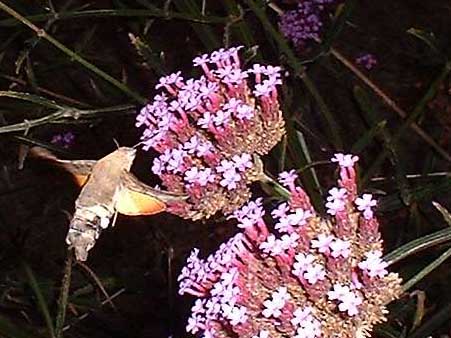 13
October 2003 13
October 2003
A
Hummingbird
Hawk-moth, Macroglossum
stellatarum, made an early evening
visit to the Verbena bonariensis to
my south Lancing garden (TQ 186 044).
Lancing
Nature Slide Show Pages (by Ray Hamblett)
The
Pied
Wagtails,
Motacilla
alba, seem to have foregone their
attempt to roost on Courts Furniture Store and just before dusk, scores
of these small birds could be found over the Ricardo factory complex north-west
of the
Toll Bridge at Old Shoreham.
On
the mudflats south of the Toll Bridge, the
usual typical selection of seabirds had settled in the fading light: hundreds
of Black-headed Gulls,
over a hundred Lapwings,
over a dozen each of Redshanks,
Grey
Plovers and Dunlins.
There were at least two Little Egrets
and two Cormorants,
and a statuesque Grey Heron, and
a handful of Mute Swans
with full-sized cygnets.
11
October 2003
As
dusk approached, scores of Pied Wagtails,
possibly numbering over a hundred seemed to be about to roost on top of
the Courts Furniture Store (opposite McDonalds) near the Hamme in central
Shoreham. The birds descended into the single tree on the grass by
the Eastern Avenue rightangle bend just south of the railway crossing gates.
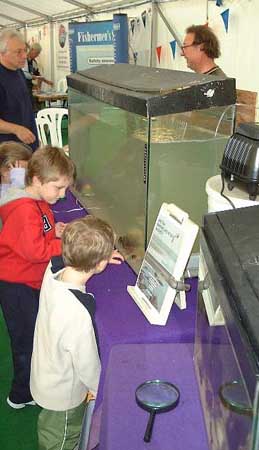
The
SHOREHAM FISH FESTIVAL on Coronation
Green, Shoreham-by-Sea,
West Sussex, was attended by 4,000 people if the sunshine as the high six
metre spring tide filled the river just before 1:00
pm. The British Marine
Life Study Society held an aquarium display
and despite technical problems with a very high plankton content in the
water (which meant the large wrasse could not
be displayed) the exhibits were well received by the younger age group.
Picture
Gallery
Two
Painted Lady Butterflies in my
North Farm Road, Lancing, front garden (TQ
186 044) turned out to the last two of the
year.
Butterflies
of Lancing
9 October
2003
A
couple of Eider Ducks
were seen at low tide on the sand by the outfall pipe near Brooklands Boating
Lake on the Lancing/Worthing border.
Report
by June Brown
Three
Stonechats,
one Little Egret
and two Sandwich Terns
were seen at Widewater, Lancing.
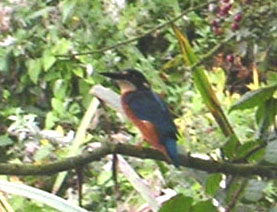 8
October 2003 8
October 2003
A Kingfisher
was
seen by Roy Bratton
at the Cokeham
Reed Beds, west Lancing.
Kingfisher
Photograph
by Roy Bratton
Bird
List for Cokeham
About
50 Common Darter Dragonflies,
Sympetrum
striolatum, and at least a
couple of Migrant Hawkers, Aeshna
mixta, were seen on the approaches
to and on the lower slopes of Mill
Hill in the early afternoon. There
were a handful of butterflies about including
a female Meadow
Brown and a Clouded
Yellow.
Butterfly
Report
Adur
Dragonflies
Adur
Butterflies
8 October
2003
Two
Kingfishers
and two Water Rails,
Rallus
aquaticus, were seen near Cuckoo's
Corner, on the Coombes Road. This is assumed to be by the freshwater Ladywell
Stream.
Water
Rails are very shy and secretive birds that
hide amongst the reeds, and this is the first record known to me in the
lower Adur valley. The Sussex
Ornithological Society status for this
water bird is as a scarce resident, winter vagrant or passage migrant.
There are dense reed beds on the east side of the river near
the Waterworks and patches near New Salts Farm (approach to the airport
from the south), but the Shoreham & District
Ornithological Society has this bird recorded
as a migrant seen in harsh weather. The day was exceptionally mild for
October.
Adur
Levels
7 October
2003
A
dead Red Fox
was seen lying on the central reservation of the A27 this morning, just
east
the Withy Patch, Lancing. It looked in good condition (apart from
being dead),
very
bright red, not the sandy colour they go as they get old. The Grey
Squirrels seem
to
have deserted Lancing Manor, and the sweet chestnuts from the two trees
in the wood by the allotment were laying uneaten.
On the
syenite rock groynes on Southwick beach, four Turnstones
flew off at my approach, but I was able to get within throwing distance,
their red legs and black and white wing patterns very clearly seen.
5 October
2003
A
female
Sparrowhawk,
Accipiter
nisus, landed on a small Weeping Pear
Tree (about two metres high) where several
Sparrows
were concealed among it's branches. This all happened within five metres
of where I was standing, in the garden of a property on Old Salts Farm
Road, Lancing. The hawk failed to catch anything and after a few seconds
it took flight in a south-westerly direction.
In
sheltered parts of McIntyres Field near Lancing
Ring, there were plenty of insects including at least ten Common
Darter Dragonflies, Sympetrum
striolatum,
and one other species
of dragonfly, probably a Migrant
Hawker, Aeshna
mixta. There were seven species of
butterflies:
Red
Admiral (3),
Speckled
Wood (4),
Common
Blue female (1), Small
White (2), Large White (1), Wall
Brown (1), Comma
(1).
Adur
Dragonflies
Butterflies
of Lancing
Adur
Butterflies Flight Times
3 October
2003
It
appeared to be a large (it seemed larger than a finch) brightly coloured
greenish-yellow bird feeding in an open field (The Circus Field) by the
Steyning Road north of Old Shoreham, and was almost certainly a Yellowhammer,
Emberiza
citrinella, evidenced by its call above the hum of the continual
traffic. This bird is seen more often on nearby Mill
Hill.
Flying
over the derelict Cement Works at Upper Beeding, I spotted the grey/silver
beak of a possible Rook,
Corvus
frugilegus, which is unusual or more likely overlooked by me. (One
Rook on its own is unusual with this sociable bird.) There
were scores of Crows, Corvus
corone, around as usual throughout
the year.
Adur
Levels
2 October
2003

The
common Garden Orb Spiders,
Araneus
diadematus, were spinning numerous
and extensive webs, in gardens, hedgerows, wasteland and just about everywhere
it seems.
1 October
2003
A
Hummingbird
Hawk Moth, Macroglossum
stellatarum, was spotted feeding on
Buddleia
on a dull morning at 8:00 am.
Lancing
Nature Slide Show Pages (by Ray Hamblett)

All
reports by Andy Horton unless the credits are given
to other observers or reporters. |


